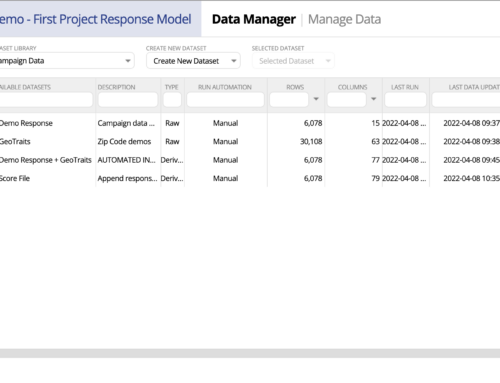Digital Advertising is Ripe for Optimization
Machine learning through approaches like predictive analytics has the power to drastically improve your digital media ROI.
Given the nature of the digital medium, it’s easy to know, pretty quickly how campaigns are performing and who’s responding through an open, click, or conversion. This accessibility to performance data makes it ripe for the use of predictive analytics and optimization.
In business, predictive models identify and leverage patterns found in historical and transactional data to identify risks and opportunities. Models have the ability to capture relationships among many factors to allow assessment of risk or potential associated with a particular set of conditions. In short, this information makes you smarter about how you’re advertising online, where your investments are made, and who you’re targeting.
A 2016 Aberdeen report illustrates the impact of predictive analytics across the business.
The State of Digital Marketing
Consumer behaviors and expectations are evolving when it comes to digital marketing. The more information and predictive tools marketers and advertisers have access to, the better the performance of email, social, display, and paid search will be.
Here’s a look at the state of digital marketing channels as it relates to smarter, more predictive approaches.
Email:
- The ability to segment email lists and individualize email campaign messaging are the most effective personalization tactics for 51% and 50% of marketing influencers respectively. (Ascend2, 2016)
- The ability to segment email lists and individualize email campaign messaging are the most effective personalization tactics for 51% and 50% of marketing influencers respectively. (Ascend2, 2016)7
- Segmented and targeted emails generate 58% of all revenue. (The Direct Marketing Association, 2015) 7
- 51% of marketers say enriching contact data quality is their most significant barrier to achieving email marketing success. (Ascend2, 2016)
Social:
- 88% of marketers want to know how to measure their return on investment for social media activities. (Social Media Examiner, 2015)
- Only 42% of marketers say they are able to measure their social activities. (Social Media Examiner, 2015) 7
- Nearly one-third of the world uses social networks regularly. (eMarketer, 2016)
Display Advertising:
- Advertisers’ use of third-party data, which marketers buy from a range of external sources that don’t have a direct relationship with the consumer, is also set to rise by 30 percent in the next two years, according to the same report.
- Overall, digital ad revenue grew 21.4 percent to $88 billion in 2017. To put that in perspective, PwC says the revenue change in digital seen last year is greater than in the newspaper industry as a whole. 9
- Social’s share of revenue topped 25.2 percent in 2017, reaching $22.2 billion. Facebook, of course, accounts for the bulk of social media advertising spend in the US.9
Paid Search:
- Between customer match, remarketing lists for search ads, and similar audiences, ads targeted to specific audiences accounted for 34 percent of Google search ad clicks at the end of Q1 2018, up 19 percent from last year.10
- Google AdWords spending increased by 19 percent in 2016, but it rose even more—by 21 percent— in 2017. 10
- Ad spend for desktop computers rose by 12 percent and ad spend for mobile phones grew by 51 percent. 10
What Does All of This Mean?
It means that companies are spending more than ever to get in front of audiences, and marketers are getting smarter about how and where they place their investments. There’s more competition for attention than ever before, so as a business, you must get smarter about how you invest in digital marketing and advertising.
There Are Fewer Barriers
With the democratization of data and access to 1st, 2nd, and 3rd party data and predictive analytics technology, marketers no longer have to rely on assumptions about consumer behavior. Instead, they can deliver ads targeted specifically to individuals based on hundreds of characteristics including demographics, psychographics, and online behavior. These types of thoughtful, targeted efforts are more effective at generating both clicks and conversions and ultimately less money spent to increase revenue.
Insights Only Won’t Cut It
Descriptive analytics, or insights, is just reporting. We have all had the experience of looking at a report that offers no attempt to bridge the insights-to-action gap. Even if we provide key insights through descriptive analytics, it doesn’t get us to the point of being able to recommend actions from those insights. We may not know and/or the analysis may not be clear. This is where the more advanced types of analytics become useful and tell us what action we should take. We will still likely want to have the less complex types of analytic output to help explain why.
Gartner has a useful chart that depicts the insights-to-action gap in which they illustrate the size of the gap getting smaller and non-existent as you move from descriptive analytics to prescriptive analytics.
This chart illustrates the value of advanced analytics in its ability to inform and improve your marketing efforts.
Get Smarter About Your Targeting and Spend
A recent Smart Insights article shares steps to mapping measurements and leveraging predictive analytics to improve your digital marketing ROI:11
- Track each and every tactic in a campaign. There’s nothing to report on or measure if you’re not tracking before, during, and after a campaign. Weigh on the side of caution and track every tactic involved.
- Prepare and predict results prior to a campaign. The results from a simple predictive model not only can set expectations aptly, but they also can better inform budgets when shared with clients.
- Avoid nonsense metrics. If the metric isn’t directly related to customer acquisition or conversion, it’s really not necessary. Take, for example, display banner impressions or Facebook likes. These metrics may say something about reach but not conversion.
- Continue testing. Even if a client is happy with the improvements to ROI, don’t take that as a cue to stop testing ways for further improvements. Even when this means a period of fluctuation, the client must hang on for the ride.
- Trust your predictions. The time and effort put into predictive modeling should never go to waste. The predictions should always be trusted and shared with the client — even if the results are not so great.




